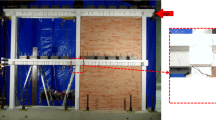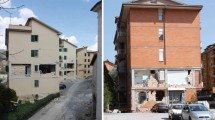Abstract
Surveys on damaged and collapsed reinforced concrete (RC) buildings following recent earthquakes indicated that poor performance is associated with the influence of unreinforced masonry (URM) infill walls. In the event of an earthquake, a typical URM infill wall is subjected to a three-dimensional acceleration field and undergoes simultaneous in-plane (IP) and out-of-plane (OoP) loading. Depending on the direction of the seismic action, the observed damage mechanisms for URM infill walls may be classified as IP and OoP performance failures or a combination of both. Since the turn of the millennium, there have been a number of distinct experimental studies in the field of infilled frames, addressing the OoP response of URM infill walls. This has led to a number of numerical macro models able to represent the OoP behavior of the URM infill wall. The main limitation of the proposed models is the difficulty in using them as practical models, since all the proposed models were implemented in software tools without a graphical user interface (GUI), such as OpenSees. In this paper, one of the recently presented models is utilized and a methodology presented for a more practical and user-friendly implementation. The model previously validated using OpenSees is recalibrated and revalidated using the computer software SAP2000, which has a powerful GUI utilizing the material models and numerical elements available in the program library. The model considers the IP and OoP response as well as their interaction. For the determination of failure patterns, respective local damage grades for primary (frame) and secondary (infill wall) elements are defined. Finally, a four-story RC frame structure with URM infill walls, which was tested in the European Laboratory for Structural Assessment considering the IP response only, is used to assess the combined failure mechanism of URM infill walls through the concept of interaction curves.














Similar content being viewed by others
References
Abrahamczyk L, Schwarz J, Lobos D, Maiwald H (2010) Das Magnitude 8.8 Maule (Chile)-Erdbeben vom 27. Februar, 2010—Ingenieuranalyse der Erdbebenschäden. Bautechnik 87(8):462–473
Abrahamczyk L, Schwarz J, Leipold M (2016) Normenbezogene Schadenserwartung von Stahlbetonrahmensystemen in Schwach- und Starkbebengebieten. Bautechnik 93(4):265–277
Al Hanoun MH, Abrahamczyk L, Schwarz J (2017) Numerical simulation of RC frame structures with infill walls under consideration of out-of-plane behavior. In: Proceedings 16th world conference on earthquake engineering (WCEE), Santiago, Chile, 9–13 January 2017, paper-no 4917
Braga F, Manfredi V, Masi A, Salvatori A, Vona M (2011) Performance of non-structural elements in RC buildings during the L’Aquila, 2009 earthquake. Bull Earthq Eng 9:307–324
Cardone D, Perrone G (2015) Developing fragility curves and loss functions for masonry infill walls. Earthq Struct 9:257–279
Cavaleri L, Di Trapani F (2014) Cyclic response of masonry infilled RC frames: experimental results and simplified modelling. Soil Dyn Earthq Eng 65:224–242
Cavaleri L, Di Trapani F, Papia M, Macaluso G (2015) Masonry infills and RC frames interaction: literature overview and state of the art of macromodeling approach. Eur J Environ Civil Eng 19:1059–1095
Chang G, Mander JB (1994) Seismic energy based fatigue damage analysis of bridge columns: Part 1—evaluation of seismic capacity. State University of New York, National Center for Earthquake Engineering Research
Crisafulli FJ, Carr AJ (2007) Proposed macro-model for the analysis of infilled frame structure. Bull N Z Soc Earthq Eng 40:6977
Da Porto F, Guidi G, Dalla Benetta M, Verlato N (2013) Combined in-plane/out-of-plane experimental behavior of reinforced and strengthened infill masonry walls. In: Proceedings: 12th Canadian masonry symposium, Vancouver, British Columbia
Dolsek M, Fajfar P (2008) The effect of masonry infills on the seismic response of a four-storey reinforced concrete frame—a deterministic assessment. Eng Struct 30:1991–2001
FEMA356 (2000) Prestandard and commentary for the seismic rehabilitation of, buildings edn. Federal Emergency Management Agency, Washington (DC)
Furtado A, Rodrigues H, Arede A, Varum H (2015) Simplified macro-model for infill masonry walls considering the out-of-plane behavior. J Earthq Eng Struct Dyn 45:507–524
Furtado A, Rodrigues H, Arede A, Varum H (2016) Experimental evaluation of out-of-plane capacity of masonry infill walls. Eng Struct 111:48–63
Grünthal G, Musson RMW, Schwarz J, Stucchi M (1998) European Macroseismic Scale 1998. Cahiers de Centre Européen de Géodynamique et de Séismologie, Volume 15, Luxembourg
Kadysiewski S, Mosalam KM (2009) Modeling of unreinforced masonry infill walls considering in-plane and out-of-plane interaction. Pacific Earthquake Engineering Research Center, PEER, p 102
Mander JB, Priestley MJN, Park R (1988) Theoretical stress–strain model for confined concrete. J Struct Eng 114:1804–1826
McKenna F, Fenves G, Scott M, Jeremic B (2000) Open system for earthquake engineering simulation (OpenSees) http://opensees.berkeley.edu
Mosalam KM, Günay S (2015) Progressive collapse analysis of reinforced concrete frames with unreinforced masonry infill walls considering in-plane/out-of-plane interaction. Earthq Spectra 31(2):921–943
Negro P, Verzeletti G, Magonette GE, Pinto AV (1994) Tests on a four-storey full-scale R/C frame designed according to Eurocodes 8 and 2. Preliminary report. Report EUR 15879, European Commission, Joint Research Centre, Ispra, Italy
Nelson Ponnu Durai T, Arunachalam J, Avinash Karthich L, Haran Pragalath DC, Iswarya D, Singh R (2016) Computational model for infill walls under cyclic loads. Int J Appl Eng Res 11:2786–2790
Noh NM, Liberatore L, Mollaioli F, Tesfamariam S (2017) Modelling of masonry infilled RC frames subjected to cyclic loads: state of the art review and modelling with OpenSees. Eng Struct 150:599–621
Rodrigues H, Varum H, Costa A (2010) Simplified macro-model for infill masonry panels. J Earthq Eng 14:390–416
SAP2000 (2005) Linear and nonlinear static and dynamic analysis and design of three-dimensional structures, vol 10. Computers and Structures, Inc., Berkeley
Schwarz J, Abrahamczyk L, Leipold M, Swain TM (2006) Damage description for earthquake risk assessment. In: Proceedings: 1st European conference on earthquake engineering and seismology (1st ECEES), Geneva, Switzerland
Schwarz J, Abrahamczyk L, Leipold M, Wenk T (2015) Vulnerability assessment and damage description for R.C. frame structures following the EMS-98 principles. Bull Earthq Eng 13(4):1141–1159
Sharma A, Elegihausen R, Reddy GR (2013) Pivot hysteresis model parameters for reinforced concrete columns, joints and structures. ACI Struct J 110–S19:217–227
Stafford-Smith B (1996) Behavior of square infilled frames. J Struct Div ASCE 92(ST1):381–403
Wenk T, Lacave C, Peter K (1998) The Adana-Ceyhan earthquake of June 27, 1998: report on the reconnaissance mission from July 6–12, 1998 of the Swiss Society of Earthquake Engineering and Structural Dynamics (SGEB), Swiss Society of Earthquake Engineering and Structural Dynamics, 1998 (705.85 1998 W46)
Acknowledgements
This research was supported by the German Research Foundation (DFG) via the Research Training Group “Evaluation of Coupled Numerical and Experimental Partial Models in Structural Engineering (GRK 1462)”. This support is gratefully acknowledged by the authors.
Author information
Authors and Affiliations
Corresponding author
Appendix: One-panel parameter calculations
Appendix: One-panel parameter calculations
The determination of the macromodel parameters for the model construction and post-analysis evaluation is presented here (Table 4). The example chosen is the second-story 6 m-long infilled panel of the structure tested in Negro et al. (1994).
Post-analysis URM evaluation | ||
IP limit (drift) | \(\upbeta = \frac{{{\text{V}}_{\text{frame}} }}{{{\text{V}}_{\text{URM}} }} = \frac{270 kN}{163 kN} = 1.7 > 1.3\); \(\frac{{{\text{L}}_{\text{URM}} }}{{{\text{H}}_{\text{URM}} }} = \frac{4000}{3050} = 1.3\) | 34 (mm) |
FEMA 356, Table 7–9, linear interpolation \(\left\{ {\left. {\begin{array}{*{20}l} {\frac{{{\text{L}}_{\text{URM}} }}{{{\text{H}}_{\text{URM}} }}} \hfill \\ {\left[ - \right]} \hfill \\ {0.5} \hfill \\ {1.0} \hfill \\ {2.0} \hfill \\ \end{array} } \right|\begin{array}{*{20}c} {{\text{IP}}\;{\text{limit }}\left( {\text{drift}} \right)} \\ {\left[ \% \right]} \\ {1.5 } \\ {1.2} \\ {0.9} \\ \end{array} } \right\}\) | ||
1.1% of story height (according to Kadysiewski and Mosalam (2009) and FEMA 356) | ||
OoP limit (drift) | \(min\left\{ {\begin{array}{*{20}c} {5\% } \\ {0.5*t_{URM} /H_{URM} } \\ \end{array} } \right\} = \left\{ {\begin{array}{*{20}c} {5\% } \\ {0.5*112/3050} \\ \end{array} } \right\} = \left\{ {\begin{array}{*{20}c} {5\% } \\ {1.83\% } \\ \end{array} } \right\}\) | 56 (mm) |
1.83% of story height (according to Kadysiewski and Mosalam (2009) and FEMA 356) | ||
Linear interaction curve | ||
UIPH_top, UIPH_bot: | IP top and bottom horizontal displacement of the URM infill panel, relative to the ground. | |
UIPV_top, UIPV_bot: | IP top and bottom vertical displacement of the URM infill panel, relative to the ground. | |
δIP_t: | IP relative displacement at each time step (according to Kadysiewski and Mosalam (2009)) \(\delta_{IP\_t} = \left( {U_{IPH\_top } -_{ } U_{IPH\_bot } } \right) - \left( {\frac{{H_{col} }}{{L_{Bem} }} } \right)\left( { U_{IPV\_top} -_{ } U_{IPV\_bot } } \right)\) | |
UOoP_top, UOoP_mid, UOoP_bot: | top, mid-, and bottom node out-of-plane displacement of the URM infill panel relative to the ground. | |
δOoP_t: | OoP relative displacement at each time step (according to Kadysiewski and Mosalam 2009) \(\delta_{OoP\_t} = \left( {U_{OoP\_mid } } \right) - 0.5\left( { U_{OoP\_top} + U_{OoP\_bot } } \right)\) | |
Rights and permissions
About this article
Cite this article
Al Hanoun, M.H., Abrahamczyk, L. & Schwarz, J. Macromodeling of in- and out-of-plane behavior of unreinforced masonry infill walls. Bull Earthquake Eng 17, 519–535 (2019). https://doi.org/10.1007/s10518-018-0458-x
Received:
Accepted:
Published:
Issue Date:
DOI: https://doi.org/10.1007/s10518-018-0458-x




